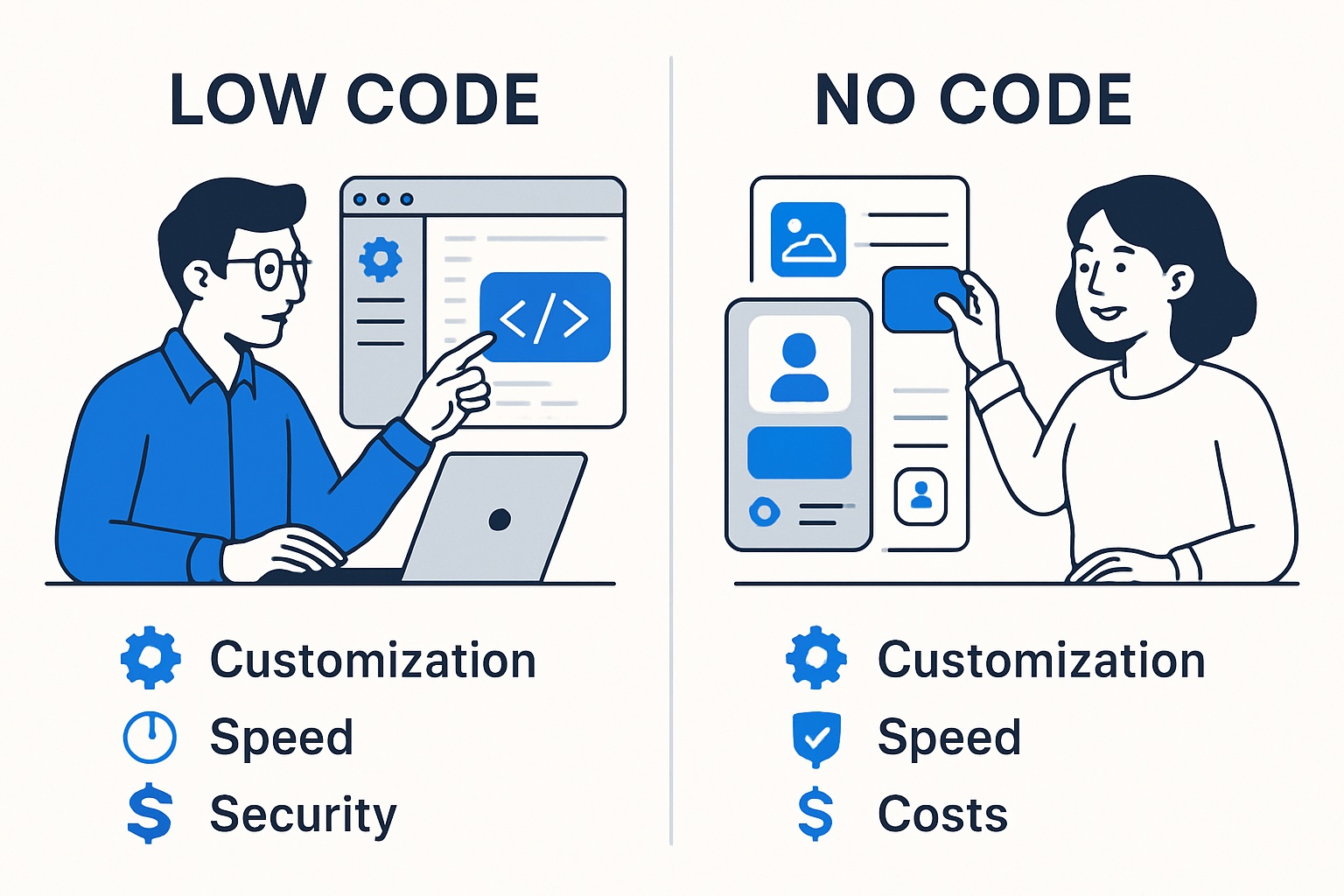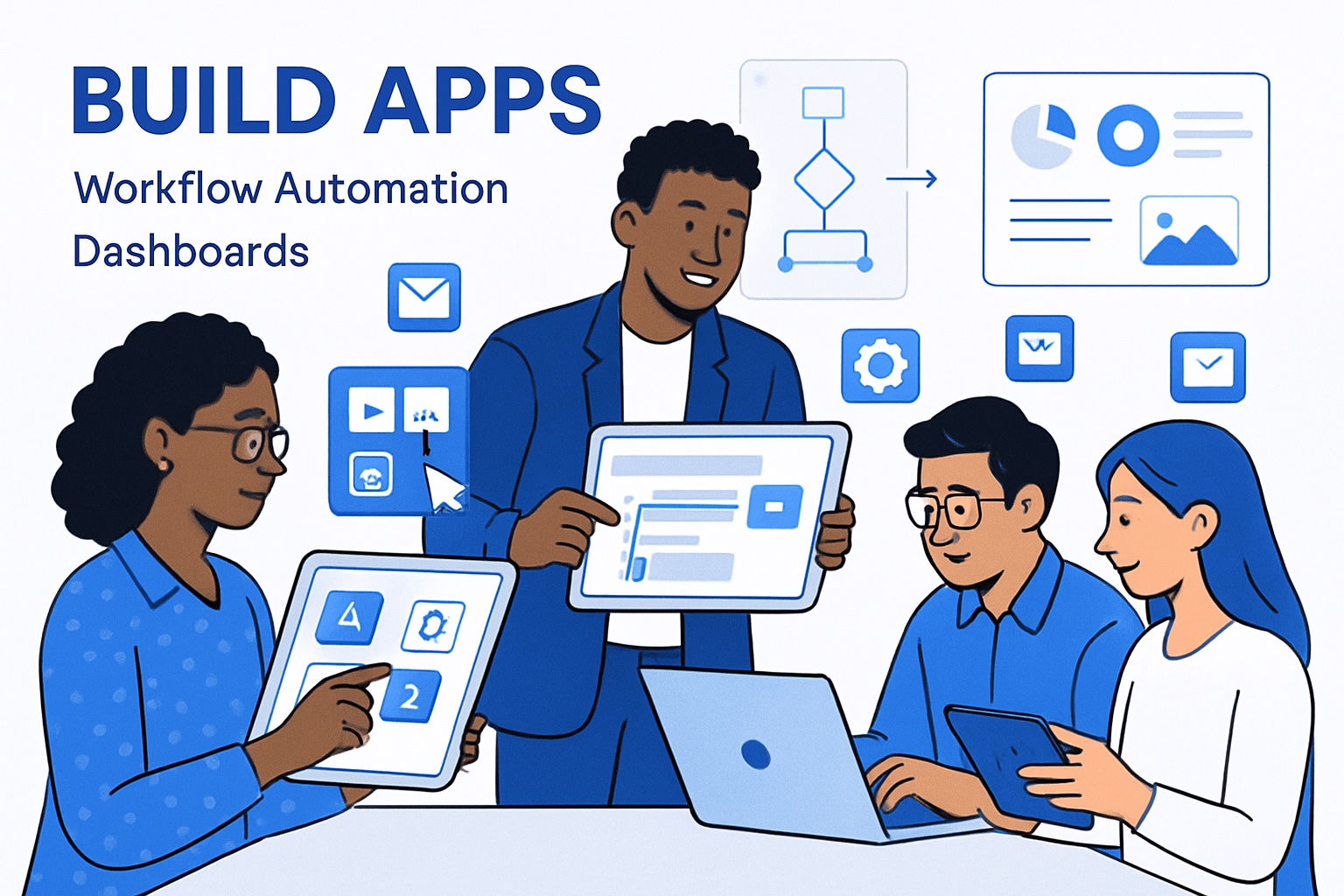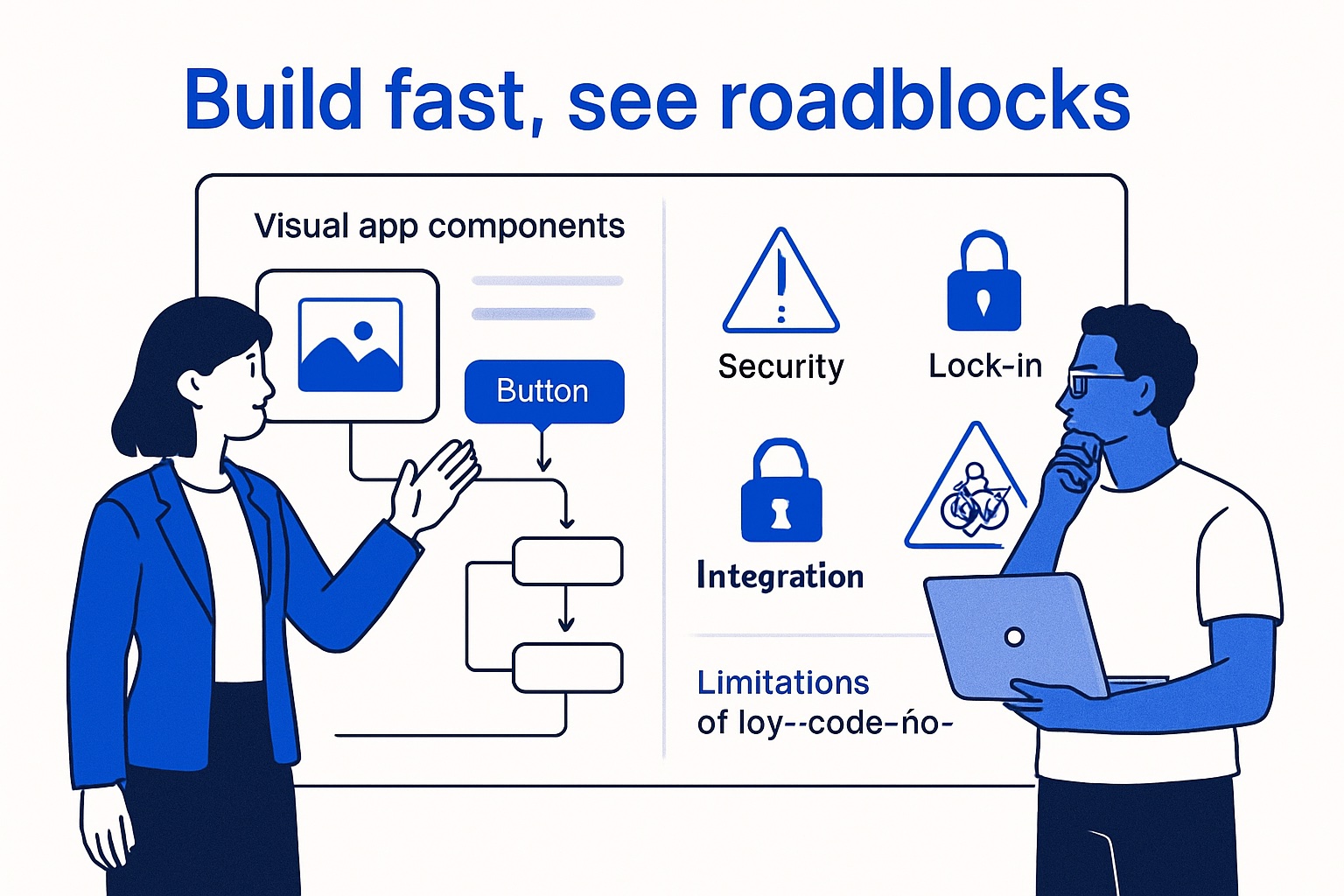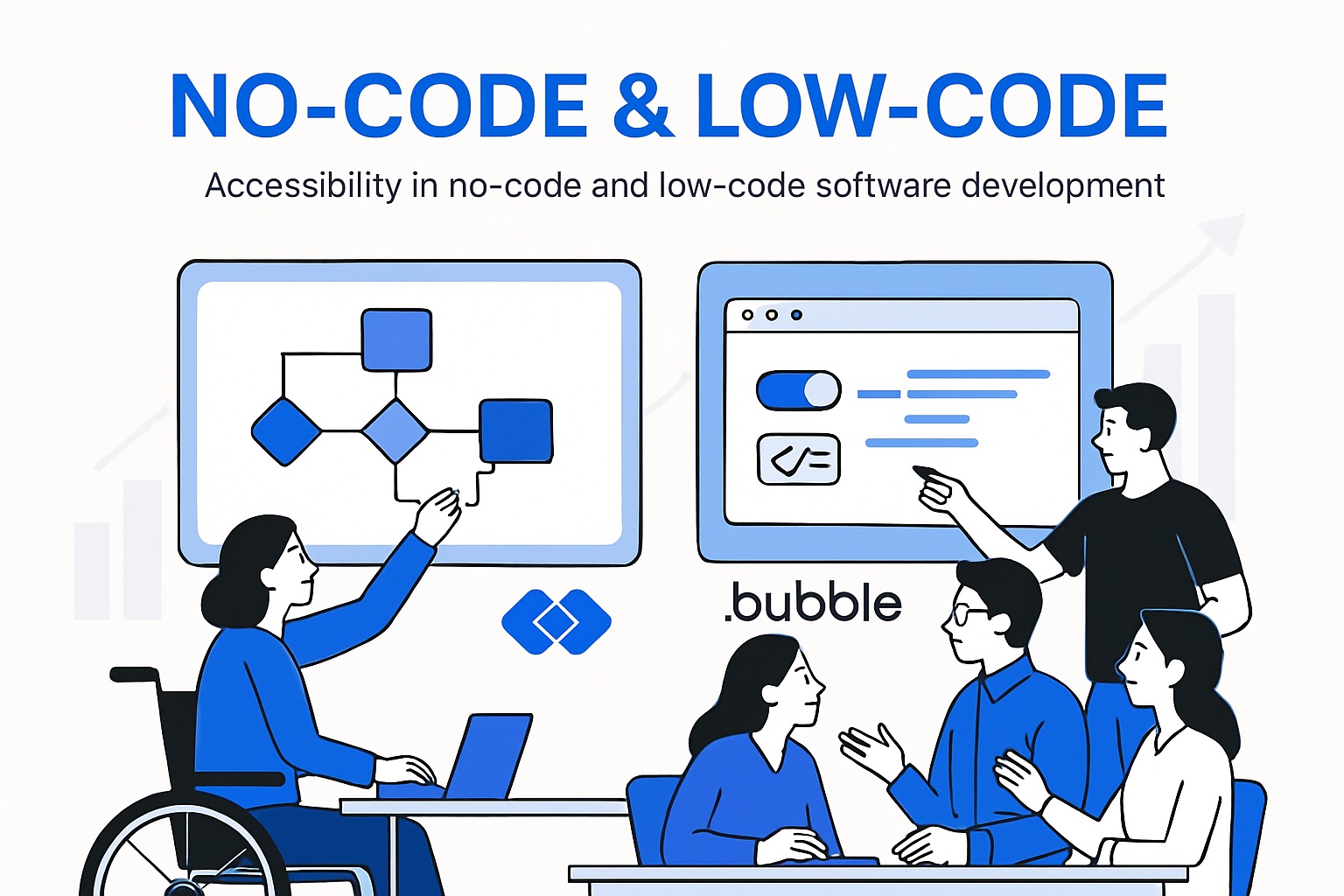In 2025, the low code no code conversation is at the forefront as organizations race to digitize, automate, and innovate faster than ever before. Traditional development simply can’t keep up with the demand for rapid transformation, making these platforms a critical solution for many businesses.
This article breaks down the essential differences, benefits, and limitations of low code no code approaches. We’ll define each method, highlight their core distinctions, explore real-world use cases, and compare their pros and cons. By the end, you’ll have actionable insights to help you select the right strategy for your organization’s unique needs in a fast-changing digital landscape.
Understanding Low-Code and No-Code Development
Digital transformation is accelerating, and the low code no code debate is shaping how businesses build software in 2025. Both approaches promise to speed up development, cut costs, and open new doors for innovation.
Definitions and Core Concepts
Low code no code platforms are transforming how software gets built. But what do these terms really mean?
Low-code development uses visual interfaces and prebuilt components, but still allows for some scripting or custom code. This means users with basic programming knowledge can build complex applications quickly, often integrating with existing systems.
No-code development takes it a step further: users build apps entirely with visual tools and configuration, requiring zero programming. Business users, not just IT professionals, can automate workflows or create digital products.
The rise of low code no code is driven by several factors. Organizations want to deliver solutions faster, keep costs under control, and tackle the ongoing shortage of skilled developers. According to TechTarget, these platforms are experiencing rapid adoption because they address these urgent needs.
A key movement fueling this growth is the "citizen developer" trend. Business analysts, operations staff, and other non-technical team members are empowered to solve problems without waiting for IT. Platforms like Microsoft Power Platform (a leader in low-code) and Bubble (a standout in no-code) are at the forefront of this shift.
Both low code no code approaches democratize software creation, but they target different user skill levels. Low-code is ideal for IT teams and tech-savvy users, while no-code opens the door to anyone with a business challenge to solve. For more on how no-code is empowering business users, see Empowering non-technical teams with no-code.
The bottom line: as digital transformation pressures mount, the distinction between low code no code platforms matters more than ever.
How the Platforms Work
So, how do low code no code platforms actually operate? Both rely on intuitive, drag-and-drop interfaces. Users select prebuilt components—like forms, data tables, or workflow steps—and assemble them visually.
Back-office functions, such as data handling or user authentication, are encapsulated within these platforms. Users focus on logic and process, not on writing code from scratch.
The difference often comes down to technical skill and customization potential. With low code no code platforms, anyone can build a basic internal tool by dragging elements into place. But if you want to add advanced integrations, custom scripts, or connect to an external API, low-code gives you that flexibility, while no-code keeps you within the platform's preset options.
For example, imagine building a simple leave request form for HR. No-code lets you create the form, set up notifications, and track approvals in minutes. But if your business needs to sync this with a custom payroll system, low-code platforms allow you to script that integration.
While the line between low code no code is blurring—some platforms now offer both options—the core distinctions remain: who can use them, how much can be customized, and what kinds of problems they solve.
In 2025, understanding these differences is essential for making the right technology choices.
Key Differences Between Low-Code and No-Code in 2025
Navigating the world of low code no code in 2025 means understanding not just what these platforms can do, but who they empower and how they shape digital transformation. While both approaches promise faster, more accessible software development, the real differences emerge in user profiles, customization potential, complexity, speed, security, and cost. Let’s break down the critical distinctions that will help you decide which path best fits your organization’s goals.

User Profiles and Skill Requirements
One of the most fundamental differences between low code no code platforms lies in who they are designed for. Low-code tools are typically geared toward professional developers, IT teams, and tech-savvy business users who are comfortable with some scripting or logic. These users can leverage visual interfaces but also dive into code when needed.
No-code platforms, however, are purpose-built for non-technical staff: business analysts, administrators, entrepreneurs, and even those with zero programming experience. An example is a business analyst automating a multi-step approval workflow in a no-code tool, while a developer might use low-code to extend a CRM’s capabilities.
Ultimately, the choice between low code no code depends on the technical expertise of your team and the complexity of the projects you want to tackle.
Customization and Flexibility
Customization is where low code no code platforms start to diverge sharply. Low-code solutions allow for custom scripting, advanced logic, and integration with external APIs. This means you can build highly tailored solutions that fit specific business processes and requirements.
No-code platforms, on the other hand, are limited to what their visual tools and built-in integrations offer. You can configure workflows and choose from prebuilt components, but you can’t add custom code or logic beyond what’s available in the platform’s toolkit.
For example, if you need to add a custom payment gateway, low-code will let you write the necessary code or connect a unique API. With no-code, you’ll be restricted to whatever payment integrations the platform already supports. The bottom line: low code no code platforms democratize app development, but low-code offers more room for advanced customization.
Application Scope and Complexity
The types of applications you can build with low code no code platforms vary considerably. Low-code is best suited for mission-critical, scalable, and complex solutions, such as ERP extensions or enterprise-grade apps. These require robust logic, integrations, and performance.
No-code shines when you need to rapidly prototype or deploy simple, departmental, or internal tools—think HR forms, dashboards, or simple customer-facing apps. For instance, a startup can launch a basic booking system in days using no-code.
A notable statistic: By 2025, 70% of new applications will use low-code or no-code technologies, highlighting the mainstream adoption of both approaches across organizations of all sizes.
Speed to Market and Iteration
Both low code no code platforms dramatically accelerate the development process compared to traditional coding. No-code is typically the fastest path for building MVPs and straightforward apps, requiring little to no technical ramp-up.
Low-code balances speed with scalability, enabling rapid prototyping while allowing for future growth and more complex features. For example, you might launch an internal HR tool in just days using no-code, while a low-code platform makes it possible to build and iterate on a customer-facing portal with third-party integrations in weeks rather than months.
The key advantage of low code no code here is the ability to quickly respond to business needs and iterate based on feedback, without long development cycles.
Security, Governance, and Maintenance
Security and governance are top concerns for organizations adopting low code no code solutions. Low-code platforms offer more granular control over security settings, compliance, and ongoing maintenance. This is especially important for enterprises with strict regulatory requirements.
No-code platforms manage most security aspects behind the scenes, which is convenient but limits your direct control. There’s also the risk of platform lock-in, where your apps are tightly bound to a vendor’s infrastructure and roadmap.
Enterprises adopting low code no code must weigh their need for flexibility and compliance against the convenience of managed security.
Cost Implications
Cost is a major factor in the low code no code decision. Both approaches cut costs compared to traditional development by reducing the need for large developer teams and lengthy timelines.
No-code platforms usually have lower upfront costs and require fewer IT resources, making them ideal for small businesses or quick-turnaround projects. Low-code may involve higher costs when advanced features or developer input are needed but pays off with long-term ROI for complex, scalable solutions.
For example, a small company might use no-code to build internal tools and avoid hiring developers, while an enterprise invests in low-code for an extensible, future-proof app. Choosing between low code no code often comes down to balancing immediate savings with long-term value.
Low code no code platforms continue to blur the lines but understanding these core differences will help you make an informed, strategic decision in 2025.
Benefits of Low-Code and No-Code Platforms
In 2025, the adoption of low code no code platforms is transforming how organizations innovate, streamline operations, and empower their teams. These tools bring a suite of benefits that accelerate digital transformation, drive efficiency, and foster collaboration across every department.

Accelerated Digital Transformation
Low code no code platforms enable businesses to move at the speed of change. With visual interfaces and reusable components, teams can build, test, and launch apps faster than ever before.
Instead of waiting months for traditional development, companies can now roll out solutions in days or weeks. This agility is crucial for staying competitive and responding quickly to customer and market demands.
In fact, low-code platforms reduce development time by up to 70%, allowing organizations to innovate continually without the typical bottlenecks of custom coding. The result? Faster prototyping, quicker feedback loops, and more rapid digital transformation.
Empowerment of Non-Technical Users
One of the most transformative benefits of low code no code is its ability to turn non-technical staff into “citizen developers.” Business analysts, office managers, and other team members can build the tools they need without writing a single line of code.
This democratization means that innovation is no longer limited to IT departments. Anyone with a problem to solve can design and launch an application, automating tasks and improving workflows.
By putting power into the hands of everyday users, low code no code platforms reduce IT backlogs and encourage a culture of continuous improvement across the organization.
Cost Reduction and Resource Optimization
Switching to low code no code development is a smart move for controlling costs. These platforms cut development and maintenance expenses by minimizing the need for specialized programmers and reducing reliance on external vendors.
Organizations can reuse templates and components, further streamlining costs. This approach also helps companies avoid the high price tag of outsourcing or hiring additional developers for every project.
Ultimately, low code no code platforms free up resources, allowing businesses to allocate budget and talent to other strategic initiatives.
Increased Productivity for Development Teams
With low code no code platforms, IT professionals can focus on high-impact, complex projects rather than routine tasks. Business users handle straightforward applications, such as approval workflows or internal dashboards, freeing up developers for more advanced work.
This division of labor boosts productivity across the board. Developers spend less time on repetitive coding, while business units see their needs met faster.
The result is a more efficient, agile organization where everyone contributes to innovation.
Flexibility and Scalability
Low code no code solutions provide the flexibility to meet evolving business needs. No code tools make it easy to update simple apps and dashboards, while low code platforms allow for deeper customization and integration when requirements grow.
Teams can quickly adapt to changes, whether it’s updating a sales report or scaling a customer portal with new features. This adaptability ensures that organizations stay future-ready.
With low code no code, growth and change are no longer obstacles but opportunities for improvement.
Enhanced Collaboration and Transparency
Visual development environments offered by low code no code platforms make it easier for business and IT teams to work together. Shared interfaces help everyone understand workflows, requirements, and goals.
Cross-functional teams can co-design applications in real-time, reducing miscommunication and speeding up the development process.
This transparency fosters trust and a unified approach to problem-solving, making it easier to deliver solutions that meet everyone’s needs.
Limitations and Challenges in 2025
As low code no code platforms continue to shape the development landscape in 2025, it's crucial to consider their inherent limitations. While these tools accelerate innovation and empower new creators, businesses must navigate several challenges to maximize their value.

Platform Limitations and Vendor Lock-In
One of the most significant concerns with low code no code solutions is vendor lock-in. Many platforms rely on proprietary frameworks, making it difficult to migrate applications elsewhere. This can impact long-term flexibility and scalability.
Common platform limitations include:
- Rigid templates that restrict customization
- Limited extensibility for unique business needs
- Dependence on the platform’s roadmap for new features
Assessing these factors is vital when building mission-critical systems with low code no code tools.
Security and Compliance Concerns
Security remains a top priority for organizations adopting low code no code platforms. No-code tools often abstract away the codebase, giving users less control over data security and compliance settings.
Enterprises must evaluate:
- How data is stored and protected
- What compliance certifications the platform holds
- The ability to enforce internal governance policies
According to TechTarget, security is a top concern for 60% of enterprises exploring low code no code development. For regulated industries, this challenge can be a deal-breaker.
Customization and Integration Challenges
Not every business process fits neatly into prebuilt modules or drag-and-drop workflows. No-code platforms, in particular, can struggle with deep integrations or unique logic requirements. While low-code offers more flexibility, it may still require custom connectors or API work.
If your organization needs to connect legacy systems, handle complex data flows, or implement advanced features, you’ll likely encounter these hurdles. For a deeper dive into the limitations and business impacts of no-code, see The impact of no-code on digital product development.
Maintenance and Upgrades
Applications built on low code no code platforms are subject to the vendor’s update schedule. When platforms roll out new features or changes, existing applications may break or require rework.
Ongoing maintenance also means:
- Training new staff on platform changes
- Monitoring updates for compatibility issues
- Ensuring documentation is up to date
Both approaches require strong governance to prevent shadow IT and maintain quality over time.
User Experience and Design Constraints
No-code platforms often offer limited options for branding, advanced UI/UX, or unique customer journeys. Low-code tools provide more design freedom, but may need additional design skills.
Common constraints:
- Standardized interfaces that lack customization
- Limited support for responsive or mobile-first design
- Fewer options for accessibility enhancements
This can make it challenging to use low code no code platforms for highly branded or customer-facing applications.
Organizational Change and Adoption Barriers
Adopting low code no code platforms isn’t just a technical shift—it’s a cultural one. IT teams may resist, fearing loss of control, while business users may hesitate to embrace new tools.
Overcoming barriers involves:
- Setting clear governance and best practices
- Providing training for all user groups
- Securing buy-in from leadership and IT
Success with low code no code requires a strategic approach, ongoing support, and open communication across teams.
Use Cases and Industry Applications
The low code no code movement is transforming how companies approach software development in 2025. From startups to global enterprises, these platforms are opening new doors for rapid innovation. Let’s break down where low code no code shines across different business needs and industries.
Common Use Cases for No-Code
No-code solutions are perfect for teams seeking speed and simplicity. The most common low code no code applications here are:
- Internal tools (HR portals, finance dashboards, approval workflows)
- Simple customer-facing apps (online forms, booking systems, surveys)
- MVPs for startups and rapid prototyping
For example, a small business can use no-code to launch a booking system in days, saving time and development costs. Enterprises are increasingly turning to no-code for internal tool development to empower non-technical staff and boost efficiency. The low code no code approach lets business users build and iterate without waiting on IT.
Common Use Cases for Low-Code
Low-code platforms extend capabilities for more complex needs. Typical low code no code use cases include:
- Enterprise-grade applications (CRM and ERP extensions)
- Complex workflows and automation (supply chain, compliance tracking)
- Integration with legacy systems and third-party APIs
A large enterprise, for instance, might automate supply chain processes using low-code, connecting multiple systems with custom logic. This level of flexibility makes low code no code ideal for organizations that need scalable, tailored solutions beyond what no-code alone can offer.
Industry Examples
Low code no code platforms are making waves across industries:
- Healthcare: Rapid patient intake forms (no-code) and integrated EHR solutions (low-code)
- Finance: Expense submission forms (no-code) and compliance tracking tools (low-code)
- Retail: Inventory dashboards (no-code) and omnichannel integrations (low-code)
This versatility is why low code no code solutions are now a staple in digital transformation strategies.
Trends in 2025
In 2025, low code no code adoption is accelerating, especially in regulated industries like healthcare and finance. Organizations are increasingly blending both approaches, leveraging hybrid platforms for optimal results.
A notable trend is the rise of platforms that let teams start with no-code and scale into low-code as needs grow. By 2025, an estimated 70% of organizations will use low code no code tools for at least some application development. This shift is making software creation more accessible and strategic than ever before.
How to Choose: Strategic Considerations for 2025
Selecting the right low code no code approach in 2025 means looking beyond surface features. It's about aligning your technology choices with business goals, users’ skills, and future needs. Let’s break down the strategic steps that help organizations make confident decisions.
Assessing Business Needs and Objectives
Begin by defining what you truly need. Is your project a simple tool for internal use, or a complex, customer-facing app that must integrate with existing systems? Consider who will build and maintain the solution. If your team lacks coding skills, no-code platforms may be ideal. For advanced customization and integration, low-code is often better. For a deeper dive into evaluating options, check out this guide on choosing the right no-code platform. Matching project requirements with user skills ensures the low code no code approach fits your actual needs.
Balancing Speed, Cost, and Flexibility
Speed is a key driver for adopting low code no code, but don’t overlook flexibility or long-term costs. No-code offers rapid deployment for straightforward solutions, minimizing upfront investment. Low-code provides more flexibility for scaling or customizing as needs evolve, though it may require more resources. Many organizations find success with a hybrid strategy, using no-code for quick wins and low-code for core systems. The right balance depends on your timeline, budget, and the complexity of your requirements.
Future-Proofing and Scalability
Think beyond the launch. Will your chosen platform support growth, regulatory changes, or new integrations? Low code no code tools vary in how well they handle evolving business needs. Prioritize platforms with strong vendor support, regular updates, and clear roadmaps. Consider the ease of migrating data or applications if your needs change. Planning for scalability and future maintenance reduces risk and ensures your investment stays relevant.
Governance and Security Planning
Strong governance is essential for any low code no code initiative. Establish clear policies for app development, deployment, and user access. Involve IT and security teams early to manage risks and ensure compliance. Ongoing training and support help maintain standards as more users begin building apps. By putting robust governance in place, organizations can harness the benefits of low code no code while avoiding common pitfalls.
Emerging Trends and the Future of Low-Code/No-Code
The landscape of low code no code platforms is evolving rapidly in 2025. Artificial intelligence is now at the core of most leading tools, ushering in a new generation of intelligent app builders. These platforms leverage AI to suggest workflows, automate testing, and even anticipate business needs before you do.
Imagine creating a business app where the platform recommends features, detects inefficiencies, and auto-generates logic based on your goals. This AI-driven approach not only accelerates development but also reduces common errors, empowering users to build better solutions with less effort.
Convergence and Hybrid Evolution
Another major shift in the low code no code space is the growing convergence of platforms. The lines between no-code simplicity and low-code flexibility are blurring, with many vendors now offering hybrid capabilities. This means users can start with no-code tools and seamlessly transition to low-code features as project complexity grows.
For businesses, this convergence removes barriers. Teams aren’t forced to choose between ease of use and customization. Instead, they benefit from adaptable platforms that scale with their needs, making the low code no code approach more future-proof than ever.
Expansion, Adoption, and Security Trends
Adoption of low code no code solutions is expanding beyond startups and SMBs into regulated industries and enterprise-wide deployments. Financial services, healthcare, and government are now leveraging these tools for mission-critical applications.
With this growth comes a heightened focus on security, compliance, and governance. Vendors are introducing granular permissions, audit trails, and advanced encryption to address enterprise concerns. According to Gartner, over 65% of all app development will occur on low code no code platforms by 2025, and the low-code market is projected to reach $101.7 billion by 2030, highlighting just how central these solutions are becoming.
The Future Outlook and Strategic Imperative
Looking ahead, innovation will continue to blur the boundaries between low code no code, traditional development, and AI-driven automation. Organizations will need to assess not just features, but also vendor ecosystems, extensibility, and long-term support.
Choosing the right platform is now a strategic decision, shaping how businesses innovate and compete. For a deeper dive into why no-code is leading this transformation, see No-code as the future of software. As the market matures, expect low code no code to become not just a tool, but a cornerstone of digital strategy.
If you’re weighing the pros and cons of low-code versus no-code, you’re already ahead of the curve in shaping your business for the future. Whether you’re a founder looking to launch fast or a team leader aiming to build smarter, speed to market is everything in 2025. Imagine turning your ideas into a scalable MVP in weeks instead of months—without the traditional headaches. At Big House Technologies, we’ve helped visionaries like you leap from concept to launch using powerful no-code tools. Ready to see what’s possible? Launch Your MVP in Weeks, Not Months and start building your future today.

About Big House
Big House is committed to 1) developing robust internal tools for enterprises, and 2) crafting minimum viable products (MVPs) that help startups and entrepreneurs bring their visions to life.
If you'd like to explore how we can build technology for you, get in touch. We'd be excited to discuss what you have in mind.
Other Articles
Discover the 7 best AI tool for code solutions in 2025. Compare features, pricing, and pros to boost productivity and code quality. Find your ideal AI tool now.
Discover the future of software enterprises in 2025 with insights on trends, tech, business models, and strategies to lead and grow in a changing digital landscape.
Discover the top 7 website app development company picks for 2025 Compare features pricing and trends to choose the best partner for digital success

